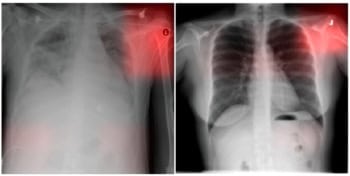A round-up of the latest international patent applications in medical imaging.
Breast scanner combines microwave and ultrasound imaging
UK diagnostic imaging company Micrima has developed a combined microwave and ultrasound imaging system (WO/2018/078315). The device comprises a microwave antenna array and an ultrasonic array, with the ultrasonic transducers interspersed between the microwave antennae. The arrays may be formed on a hemispherical substrate contoured to conform to the body part. A processor receives the microwave and ultrasonic signals and generates an image of the internal structure of a body part, such as a breast. The microwave antennae and ultrasonic transducers may be wavelength-matched to allow similar data capture, processing and rendering for the two modalities. An actuator can rotate the arrays to position the antennae and transducers at previously unoccupied positions, thus creating a virtual array with a higher density of transceivers.
Electrical impedance tomography keeps track of neonatal lung function
Swisstom has published details of an electrical impedance tomography (ΕIT) system that non-invasively monitors lung function in neonates, accurately and in real time (WO/2018/085951). The system comprises an electrode array that’s positioned on the patient to measure impedance distribution. To simplify positioning of the electrode belt, the array contains at least one visual aid that visually indicates the position of at least one electrode or electrode pair. The system also includes a data entry unit that accepts data describing the position of the visual aid, as well as a unit that calculates the position of the individual electrodes relative to the patient’ s body and provides correction for the image creation algorithm, thereby enabling computation of reliable ΕIT difference images.
GRE metric creates accurate synthetic CT images
Researchers at Memorial Sloan Kettering Cancer Center have devised schemes for creating synthetic CT images from MR images, enabling MR-only planning of radiotherapy for cancer patients (WO/2018/089753). The approach involves application of a generalized registration error (GRE) metric that determines the goodness of local registration between MR or CT image pairs. The methods also feature image processing techniques that improve the similarity between CT and MR images prior to CT-MR image registration, as well as standardization of the MR intensity histograms prior to MR-MR registration. Application of these techniques results in more accurate assignment of the Hounsfield unit to each point in the synthetic CT compared with other atlas-based methods, providing more accurate dosing in MR-only radiotherapy simulation and planning.
PET images model the human heart
Aarhus University researchers have described a method for modelling a human heart and/or its chambers and cavities (such as the left and right atrium) based on a series of PET or SPECT images (WO/2018/086667). Each image represents concentrations of a tracer that was injected at a specific time. The method involves extracting tracer time-activity curves for a number of pixels/voxels, and identifying first-pass peaks of these curves, each peak corresponding to an arrival time of the tracer at the corresponding pixel/voxel. The system then defines a model comprising at least two portions of the heart, isolated by selecting pixels/voxels based on comparisons of the first-pass peaks against a threshold. Finally, the portions are arranged in relation to each other by comparing the arrival times of the first-pass peaks of the pixels/voxels therein. The result is a segmented model of the human heart, which can be used to estimate the volume of the left or right atrium.
Multi-energy CT quantifies luminal stenosis
A team at the Mayo Foundation has designed a system for determining the severity of stenosis (narrowing) in a subject’s vasculature using multi-energy CT (WO/2018/098118). The method includes acquiring multi-energy CT data using a CT system, performing a material decomposition process on the acquired data to generate one or more material density maps, and selecting – based on these maps – one or more regions-of-interest (ROIs) encompassing at least one vessel cross-section. The method also includes measuring iodine content in the ROIs, and determining a stenosis severity based on the measured iodine content.



